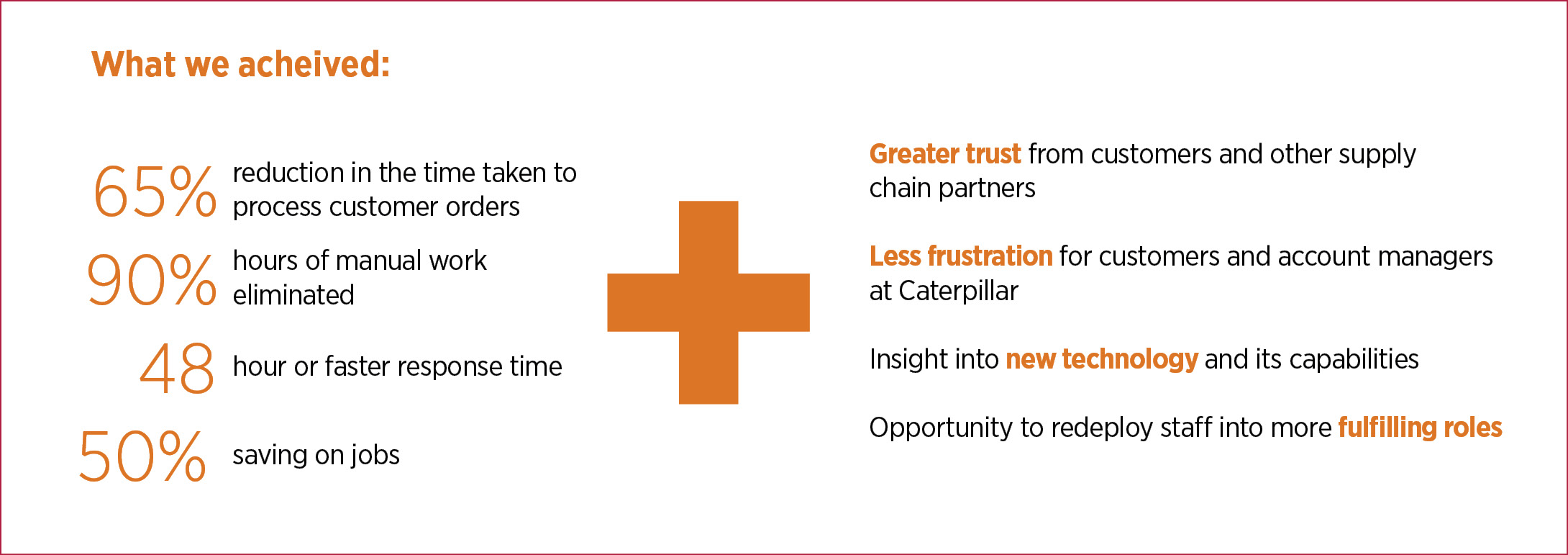Blockchain: Developing a pilot that delivered business results

How can new technologies be tested to demonstrate effectiveness? IfM’s Dr Veronica Martinez, a University Lecturer in the Cambridge Service Alliance, explains how she collaborated with Caroline Burstall and Andrew Noblett at Caterpillar to develop a pilot project to show how blockchain could deliver significant supply chain benefits for the company.
Since blockchain burst onto the scene in 2008, its evangelists have told us that – just like the internet – it will fundamentally change how we all live and work. And it clearly does have that potential.
So far, blockchain has mainly been used for cryptocurrencies, with bitcoin the most well-known example. But this digital technology is much more versatile and has a very broad set of potential uses across a range of sectors. It essentially enables traceable transactions to take place over a distributed database, with records that cannot be changed and are therefore highly secured.
Because blockchain is an open platform, companies can use it to build their own applications customised to their own needs and customers’ needs. Some are already considering how they can innovate parts of their business operations in the form of ‘private’ blockchains.
Indeed, blockchain’s versatility means it has been attracting attention as a potentially valuable technology for supply chains. Its ability to handle secure and traceable transactions could strengthen trust amongst supply chain participants as they can keep track of shipments, deliveries and product quality during transport. Blockchain is one of the top technologies that will significantly change the way consumers and providers operate. US, China, Germany among others have placed blockchain at the centre of their industrial digital transformation.
Barriers to adoption
Having a resilient, secure and traceable distributed database through which data – and payments – can be shared within and across organisations will be transformational. Firms are worrying about the consequences if they don’t get on board.
So why are we not seeing a race to adopt it? One major hurdle is the cost of implementation (particularly for those firms who have recently invested millions in state-of-the-art ERP systems) which currently outweighs its perceived but as yet unquantifiable benefits. Another is the sheer scale of the task needed to integrate it into existing company-wide systems and processes.
On top of that, most firms lack blockchain expertise and think they need to bring in consultants to help them implement it. Some of these consultants are being a little overenthusiastic in their sales pitches which is resulting in even greater circumspection among their potential customers. Adopting expensive, one-size-fits-all solutions could be a mistake for an organisation, particularly if such solutions don’t integrate with existing systems.
Even those firms that are convinced of the benefits are wary of embarking on an exercise which cedes control of the technology to a third party. Outsourcing is not only costly throughout the whole life of the implementation (making minor modifications in line with changes to the business quickly gets prohibitively expensive), it also prevents organisations from developing their ownership and understanding of the technology.
What is blockchain?
Blockchain is a revolutionary digital technology that has so far been largely applied in the financial sector particularly in cryptocurrencies such as bitcoin and smart contracts, but has much wider potential application.
Essentially, blockchain is a decentralized distributed database which appends records with timestamps. Information input into the blockchain cannot be changed, so trust amongst participants is solidified. This allows peer-to-peer transactions, and has four unique characteristics: (1) resilience, (2) safety, (3) traceability and (4) irreversibility.
Other applications include services in supply chain management, insurance, digital knowledge management and e-commerce, land management, and marketspace among others.
Low-cost blockchain pilot with Caterpillar
Our research group at the IfM has been working with Caterpillar, who were interested in exploring blockchain as a potential solution to address a business issue. One part of Caterpillar’s business sells a range of diesel and gas engines which tend to be customised to meet each customers’ needs. Managing these customer orders has remained a largely manual process over the years with modifications to the customer’s specification coming in through a variety of channels including phone, fax (yes really!) and email. These requests would then be checked by Caterpillar’s production team to make sure they were deliverable.
This back and forth process of specification and negotiation can last several days, involving six employees and, with information being stored in different formats, in different places by different people, and can be inefficient with plenty of potential to go wrong.
Blockchain was identified as a possible way to streamline this process, making it more efficient while also preserving secure, accurate information. The technology’s characteristics matched the business needs, offering ‘traceability of transactions’ – tracking who, what and when an order was placed or modified. Furthermore, it secures ‘irreversibility’ of records, offering a safe bridge of ‘trust’ between the customers and suppliers.
Caterpillar was interested in running a pilot as an initial exercise to explore and demonstrate what blockchain can offer, without heavy time and cost investment. This presented us with an exciting opportunity. Could we build our own blockchain in such a way that Caterpillar could see what it is capable of and learn from the experience without having to make a huge organisational commitment to it?
Our mission was to build and use blockchain to automate the interactions between the customer (demand) and the manufacturing site (supply). We wanted the customer to be able to place orders and make modifications easily, in other words to have a better customer experience. For Caterpillar, the aim was to harness the control and traceability that blockchain offers both to deliver that enhanced customer service while reducing the time and cost of providing it.

Do-it-yourself blockchain
The project had two key elements: programming the blockchain and simulating the business process. For the programming, we were starting with a blank sheet of paper.
With no prior experience, our first task was to decide which technologies to use, bearing in mind that one of Caterpillar’s requirements was to keep everything as simple as possible so that its employees could learn how to do it themselves. We reviewed the options and picked the most basic: Hyperledger Composer for the back end (building the blockchain) and React for the user-interface. Both applications happen to be free.
It took four of us (three students and myself) six weeks and a lot of coffee to learn how to do it (mainly from online videos) and to write and de-bug 5,000 lines of code. The other part of the process was to map the complexity of the existing system – identifying all the touch points between the firm and their customer and where the data was being stored – and to specify a more streamlined, blockchain-enabled approach. After much trial and error, we achieved our goal: a real-time method of sharing and managing data in a single record.
Achieving supply chain benefits
Once we had our blockchain in place and had tested it with one of Caterpillar’s customers, we carried out a ‘before and after’ analysis to show what we had achieved. By automating the process, we had reduced the number of storage points from twenty to two, we had reduced the time taken to process a new order by two thirds and we had halved the number of people needed to carry out the task. And we had a very positive response from the customer who was now using a bespoke user-interface which we had co-designed with its procurement team.
The final part of the project was to identify a number of potential blockchain developers (and evaluate their costs) who could work with Caterpillar to take this project forward.
What did we learn?
Our research is the first to demonstrate that blockchain improves the efficiency of the processes involved in our pilot project: it reduces the number of operations, reduces the average time of orders in
the system, reduces workload, shows traceability of orders and improves visibility to various supply chain participants. Moreover, we improved the overall customer experience.
The pilot showed that it is possible to implement blockchain in-house at a small scale and manage its growth within your business in a way which starts to give you quantifiable benefits but without introducing massive disruption and cost.
Of course, there were challenges along the way, but the benefit of this approach is that you are able to learn from those challenges, grow your own expertise in-house and develop the technology in a way that integrates with your existing systems and processes.
---
Caterpillar’s leads on this project are Andrew Noblett, Supply Chain Planning Engineer, and Caroline Burstall, Supply Chain Manager, Industrial Power System Division, Caterpillar Inc.
Reference academic paper: Martinez, V., Zhao, M., Blujdea, C., Han, X., Neely, A. and Albores, P. (2019), “Blockchain-driven customer order management", International Journal of Operations & Production Management, Vol. ahead-of-print No. ahead-of-print. https://doi.org/10.1108/IJOPM-01-2019-0100
For further information please contact:
Dr Veronica Martinez









